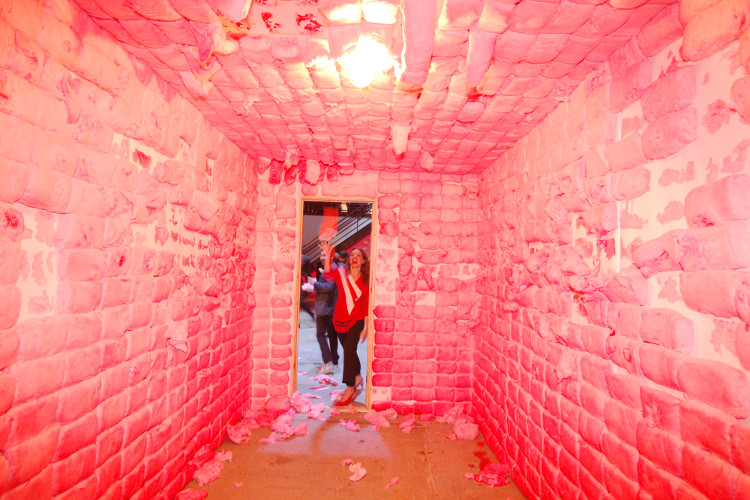How has cotton candy become popular by a dentist?
Dentists often recommend limiting the use of sweets, but historically, a special candy has become popular thanks to the efforts of a dentist.
Perhaps the image of bicycles with metal bins made of cotton candy placed behind, roaming the streets along with the seller 's adverts has become an unforgettable impression in everyone's memories. Sticks of sweet candy like sugar and white are always attractive gifts and easy for children.

Sticks of sweet candy like sugar and white are always attractive gifts and easy for children.
The most interesting thing about cotton candy sticks is not only in taste or shape, but also in how to create them . Watching the white thread suddenly show up in the spinning barrel and gradually stick around the candy bar like a miracle. In fact, if you go back in time to the years before 1900, holding such a cotton candy is a miracle.
The earliest appearance in specialty bakeries in Italy since the 15th century, where sugar syrup is boiled in a pan and "flipped" into fibers to create a decorative pattern. Due to the process of costly labor and high cost of sugar - its only ingredient, these "fiber candy" are only made in small quantities and are reserved for very wealthy families.

A room covered with cotton candy on the wall.
During the next 300 years, this candy became increasingly popular but still only for better-off, high-ranking families in society. In the late 1500s, when King Henry III of France visited Venice, he was treated to a flashy party with 1,286 different items - including tablecloths - made from spinning sugar .
Things just started to change in 1897, when a dentist, James Morrison, said that sugar products should be enjoyed by everyone. Born in Nashville in 1860, James Morrison's passion seemed contradictory. Despite being a good dentist, he is a fan of culinary advances, as well as being patented for a variety of devices.
But Morrison's biggest breakthrough came in 1897 when he was with John C. Wharton, an old friend and a confectionery hobby. Both design and name on the patent a device they called "electric candy maker". By using centrifugal force, this machine quickly melts the sugar and pulls the fiber through tiny holes until it is as smooth as cotton and contains 70% air.

Original patent for cotton candy machine by James Morrison and John C. Wharton.
Both called the candy "fairy god" and founded "Electric Candy Company" . They spent many years later perfecting the production process before launching it to the public.
At the 1904 World Fair in Louisiana, they introduced their candy product, sold it in small wooden boxes for 25 cents per box (about $ 6 today) - almost half the price of the fair. Although still quite expensive, but the candy has brought great success.
The annual World Fair attracts up to 35,000 attendees every day and is one of the birthplace of the world famous later dishes such as sausage, peanut butter, ice cream cone and now turn. Cotton candy. For over 184 days, Morrison and Wharton sold 68,655 boxes, earning 17,163.75 USD (about 438,344 USD at 2014 prices).

Advertising about electric cotton candy machine.
However, while dentist Morrison's invention flourished, it increasingly proved unstable over time. The first time it appeared, it showed its rudimentary properties: it vibrated violently, or suddenly turned off and too hot, it was also difficult to scale and reproduce.
Therefore, in 1921, shortly after Morrison's patent expired, another dentist, Josef Lascaux, reinvented the machine, but he never pursued a patent from his patent. I, and your progress has not been published. What he could do was just name the "cotton candy" and sell it to children at his medical facility. Over time, the name "cotton candy" gradually replaced the old name (although the name "fairy god" is still used in Australia today).

Today, these machines have become much more compact, efficient, stable and faster.
It was not until 1949, with the introduction of spring-mounted racks, that the cotton candy maker had the first significant upgrade. Those improvements belong to Gold Medal, who produces and sells almost 100% of cotton candy makers in the world today. During the 1960s and 1970s, a series of automation improvements were applied to the entire process - from spinning to packaging - to complete the creative process.
Today, these machines have become much more compact, efficient, stable and faster. Cotton candy is no longer confined to white cotton like at first, it is now possible to add different colors and flavorings to the sugar to produce candy sticks with different colors and aromas. Along with the change in the concept of food, sweets with high sugar levels such as cotton candy are gradually becoming absent.
- Cotton candy maker creates wound healing material
- One hundred million cotton candy lobster has one
- 7 things a dentist advises you not to put in your mouth
- Do you know what part of the Tic Tac candy box lid is used?
- American fishermen caught super rare cotton candy lobsters
- Why do some types of cotton swabs have 2 different round and pointed heads?
- The unbelievable truth about unique cotton plants in Vietnam
- How to choose a safe cotton swab
- 'Dentist' destroying dentist after 60 seconds
- Saving water for cotton plants
- Catching a 2m tall bear, 136kg weighs the house and steals candy
- Successfully restored white cotton sedge in Nga Son
 'Fine laughs' - Scary and painful torture in ancient times
'Fine laughs' - Scary and painful torture in ancient times The sequence of numbers 142857 of the Egyptian pyramids is known as the strangest number in the world - Why?
The sequence of numbers 142857 of the Egyptian pyramids is known as the strangest number in the world - Why? History of the iron
History of the iron What is alum?
What is alum?